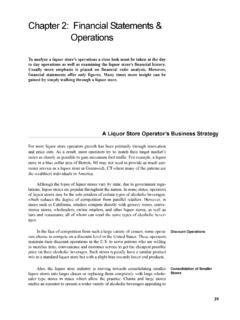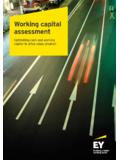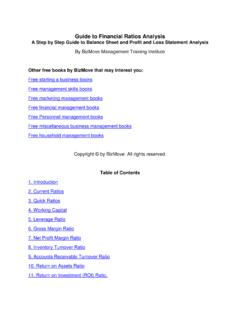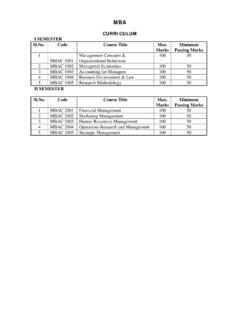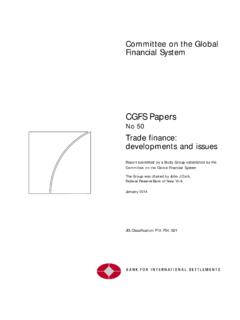Transcription of Working Capital Trends and Liquidity Analysis of …
1 IOSR Journal of Business and Management (IOSR-JBM). e-ISSN: 2278-487X, p-ISSN: 2319-7668. Volume 9, Issue 4 (Mar. - Apr. 2013), PP 45-52. Working Capital Trends and Liquidity Analysis of Fmcg Sector in India Shweta Mehrotra Research Scholar, Faculty Of Commerce, Banaras Hindu University, India. Abstract: Management of Working Capital is one of the most important functions of corporate management. Every organization whether public or private, profit oriented or not, irrespective of its size and nature of business, needs adequate amount of Working Capital . The efficient Working Capital management is most crucial factor in maintaining survival, Liquidity , solvency and profitability of the any business organization. A company needs sufficient finance to carry out purchase of raw materials, payment of day-to-day operational expenses and funds to meet these expenses are collectively known as Working Capital .
2 Keeping in view the significance of Working Capital management as a gray area of corporate finance function, an attempt has been made to examine the Working Capital Trends and practices particularity in FMCGs sector in India by selecting five FMCGs companies (named as Hindustan Unilever Limited, Nestle India Limited, Britannia Industries, Procter & Gamble and ITC). The FMCG sector in India is at present, the fourth largest sector with a total market size in excess of USD 13 billion as of 2012. This sector is expected to grow to a USD 33 billion industry by 2015. This industry primarily includes the production, distribution and marketing of consumer packaged goods, that is those categories of products which are consumed at regular intervals. The study is based on secondary data Annual Reports of the selected companies.
3 The period of study is five years and traditional method of data Analysis and ratio Analysis as tools of financial statement Analysis for examine the degree of efficiency of Working Capital management has been adopted. Keywords: Current Assets, Financial Ratios, FMCG sector, Liquidity Analysis , Working Capital management. I. Introduction The concept of WC is very vital because the term used for the Capital needed for the day-to-day operation. Adam Smith (1776) explained, The goods of the merchant yield him no revenue or profit, till he sells them for money, and the money Yields him as little till it is again exchanged for goods. His Capital is continuously going from him 8n one shape, and returning to him in another, and it is only by means of such circulation, or successive exchanges, that it can yield him profit; such Capital therefore, may very properly be called circulating Capital .
4 What we called Working Capital Smith called circulating Capital . This Capital is needed for regular business operation such as purchase of raw materials, payment of direct and indirect expenses carry on production, investment in stock and store, credit granted to customers keeping balance, etc. Decisions relating to Working Capital and short term financing are referred to as WCM. It is best described as the administration of all aspects of current assets and current liabilities. The objectives of WCM are to ensure that the firm is able to continue its operations and that it has sufficient cash flow to satisfy both maturing short- term debt and upcoming operational expenses. WCM therefore, consists of: a) considering the trade- off between costs and benefits derived from alternative levels of investment in WC and: b) managing of both control and decisions regarding stock, debtors and cash.
5 According to Harris (2005) Working Capital management is a simple and straightforward concept of ensuring the ability of the firm to fund the difference between the short term assets and short term liabilities. Nevertheless, complete mean and approach preferred to cover all its company s activities related to vendors, customer and product. (Hall, 2002). Now a day Working Capital management has considered as the main central issues in the firms and financial managers are trying to identify the basic drivers and level of Working Capital management (Lamberson, 1995). The Working Capital meets the short-term financial requirements of a business enterprise. It is a trading Capital , not retained in the business in a particular form for longer than a year. The money invested in it changes form and substance during the normal course of business operations.
6 The need for maintaining an adequate Working Capital can hardly be questioned. Just as circulation of blood is very necessary in the human body to maintain life, the flow of funds is very necessary to maintain business. If it becomes weak, the business can hardly prosper and survive. Working Capital starvation is generally credited as a major cause if not the major cause of small business failure in many developed and developing countries (Rafuse, 1996). The success of a firm depends ultimately, on its ability to generate cash receipts in excess of disbursements. The cash flow problems of many small businesses are exacerbated by poor financial management and in particular the lack of planning cash requirements (Jarvis et al, 1996). The study objectives are to examine the Working Capital management of the sample firms.
7 The amounts invested in Working Capital are often high in proportion to the total assets employed and so it is vital th at these 45 | Page Working Capital Trends And Liquidity Analysis Of Fmcg Sector In India amounts are used in an efficient and effective way. However, there is evidence that small businesses are not very good at managing their Working Capital . Objectives The study aims at analyzing the Working Capital management of FMCG (fast moving consumer goods). Sector in India. The main objectives are: To analyze the Working Capital Trends in FMCG sector;. To discover the relative importance of various current assets components;. To draw conclusion on the effectiveness of Working Capital management;. To study: How the companies handle debtors How they handle inventories How they manage other current assets Working Capital Trends and Liquidity Analysis In the present study an attempt has been made to analyze, assess and evaluate the Working Capital management (WCM) through ratio Analysis and WC Trends and Liquidity position of some selected FMCG.
8 Companies in India for the period of five years. These companies rare: Hindustan Unilever Limited (HUL), ITC. Ltd, P&G India, Britannia Industries and Nestle India. The study uses secondary data that have been extracted from the annual reports of the selected FMCG companies. The methodology followed in this study includes techniques of financial Analysis , such as ratio Analysis which deal with every aspect of WC ( Working Capital ), computation of ratios and their comparison with the fixed standards. It has been shown as company wise Working Capital Analysis . WC can solve a large portion of the firm s total assets, more than half of a typical firm s total investment is in current assets. In any industrial undertaking the major components of Working Capital are inventories, sundry debtors, cash and bank balances and loan and advances.
9 Since the level of WC determines the Liquidity position of a firm, the WC trend and Liquidity Analysis of the units under study have been discussed below. Hindustan Unilever limited (HUL). Hindustan Unilever limited (HUL) is India s largest FMCG Company with the heritage of over 75. years in India. As per Nielsen market research data, two out of three Indians use HUL products. It is owned by the British-Dutch company Unilever which controls 52% majority stake in HUL. Its products include foods, beverages, cleaning agents and personal care products. HUL was formed in 1933 as Lever Brothers India Limited and came into being in 1956 as Hindustan Lever Limited through a merger of Lever Brothers, Hindustan Vanaspati Mfg. Co. Ltd. and United Traders Ltd. Lever Brothers started its actual operations in India in the summer of 1888, when crates full of Sunlight soap bars, embossed with the words "Made in England by Lever Brothers" were shipped to the Kolkata harbor and it began an era of marketing branded Fast Moving Consumer Goods (FMCG).
10 HUL works to create better future every day and helps people feel good, look good and get more out of life with brands and services. With over 35 brands spanning 20 distinct categories such as soap, detergents, shampoos, skin care, toothpastes, deodorants, cosmetics, tea, coffee, water purifiers, etc. the company is a part of the everyday life of millions of consumers across India. Its portfolio includes leading household brands such as Lux, Lifebuoy, SurfExcel, Rin, Wheel, Fair & Lovely, Pond s, Vaseline, Lakme, Dove, Clinic Plus, Sunsilk, Pepsodent, CloseUp, Axe, Brook Bond, Bru, Knorr, Kissan, Kwality Wall s and Pureit. The company has over 16000 employees and has an annual turnover of around corers (financial year 2010-2011). Over the last two years, HUL have added one million new stores, doubling its coverage and taking the HUL products and services to some of the remotest corners.










